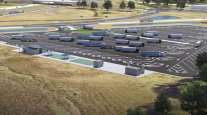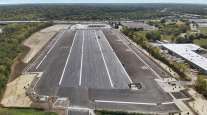Staff Reporter
Urban Planning Must Consider Freight, Engineers Say

[Stay on top of transportation news: Get TTNews in your inbox.]
ALEXANDRIA, Va. — As cities continue to embrace designs for “complete streets,” tailored for cars, bicyclists and pedestrians traveling alongside one another, urban planners should consider freight needs too, engineering experts said.
Alison Conway, an associate professor of civil engineering at the City College of New York who contributed to the guidebook “Complete Streets Considerations for Freight and Emergency Vehicle Operations,” said problems include providing adequate space for large vehicle turns, eliminating conflicts with roadway users, safely reducing speeds, supplying adequate parking and offering reliable building access.

Alison Conway by Eleanor Lamb/Transport Topics
“Unfortunately, a lot of those changes have been happening with very little consideration for freight movement,” said Conway, addressing the American Society of Civil Engineers’ International Conference on Transportation and Development on June 12.
She said it’s a nationwide problem, based on research from 10 cities.
Bike lanes have grown popular in many major cities, but Conway said they often reduce the amount of on-street parking. Lack of available truck parking ranked No. 5 on the American Transportation Research Institute’s list of industry concerns, released Oct. 29.
Conway said that one solution could be allotting sections of sidewalk space for trucks to park during deliveries, a strategy that has been explored in Paris. She also said that improved building delivery management — so drivers don’t waste time meandering the facility — could help reduce the amount of time truckers need those spaces.
Amiy Varma, an associate professor of engineering at North Dakota State University, said parking difficulties can also contribute to idling, wasted fuel, pollution and hours-of-service concerns.

Amiy Varma by Eleanor Lamb/Transport Topics
Freight movement is vital for getting goods to New York City’s more than 8.5 million residents, according to Varanesh Singh, a transportation engineer at Arup Group. Singh was part of a team that worked with New York City’s Department of Transportation to better understand freight congestion across its five boroughs.
They found that freight traffic was worst in Manhattan. The goals of the study were to improve safety and freight movement and expand partnerships with public and private entities. Singh said nearly 90% of goods delivered there are carried by truck. The rise of e-commerce has resulted in smaller trucks moving frequently through residential neighborhoods in order to deliver goods at customers’ doors.
“Without solid freight activity, New York City wouldn’t be resilient or economically viable,” Singh said. “All these trucks are competing for road and curb space with cars.”
Also at ASCE: Platooning Continues to Be Put Under Microscope at Federal Level
The research indicated that haulers sometimes drove on routes that weren’t designed for trucks when they encountered restrictions or when traffic was congested. Singh said that the team will study enforcement measures for those places where drivers are deviating from truck routes.
Singh identified for future study the impact that congestion pricing will have on freight.
New York Gov. Andrew Cuomo’s spending plan contains the Central Business District Tolling program, which will include electronic tolling devices posted along the perimeter of midtown and lower Manhattan. The Trucking Association of New York has opposed this plan.
“Freight is very important. Freight matters,” Singh said. “We have to keep hammering home that it’s important to keep moving people and goods.”




